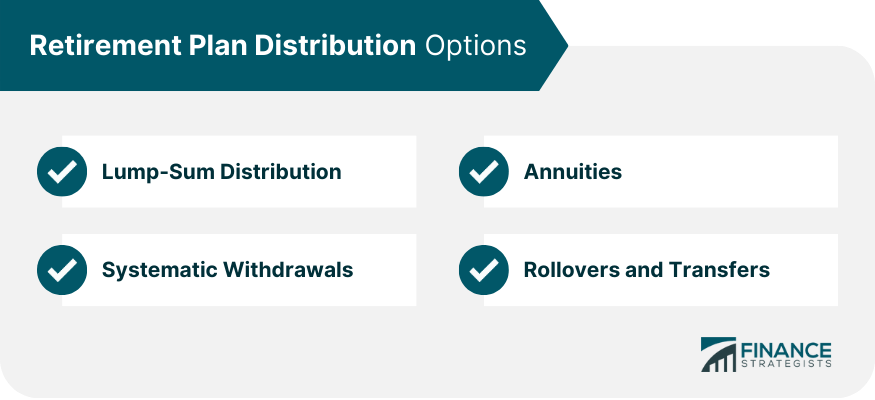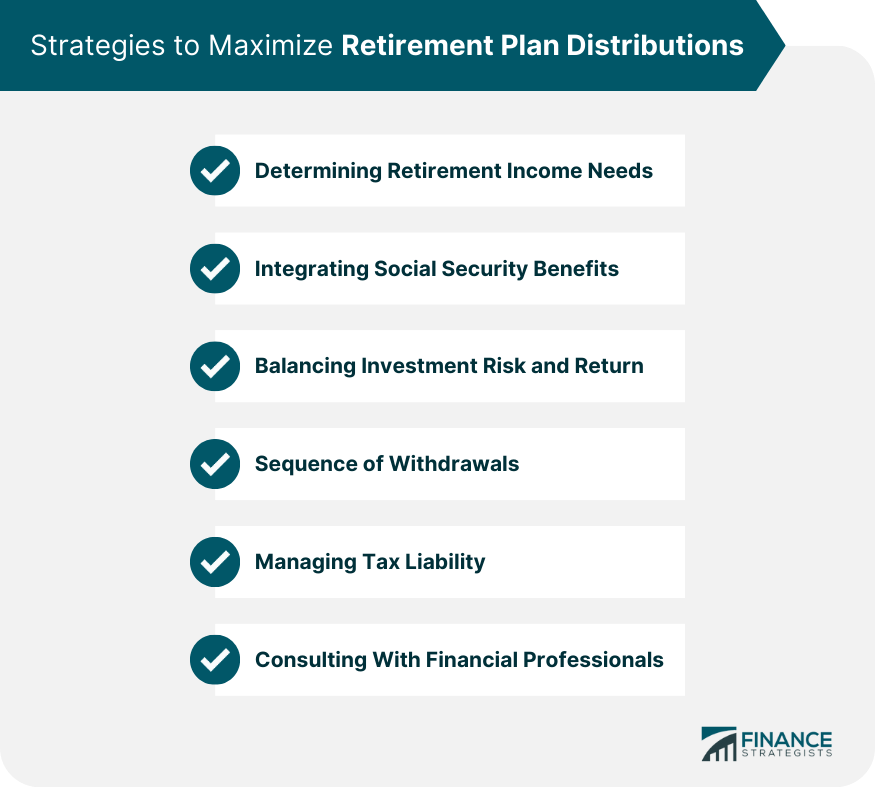A retirement plan distribution refers to the process of receiving funds from a retirement account, such as a 401(k), an IRA, or a pension plan. Distributions typically occur during retirement and are essential for providing income to retirees. Understanding the various distribution options and strategies is crucial for maximizing retirement income, minimizing taxes, and ensuring financial security during one's golden years. Different retirement plans offer various distribution options, including lump-sum distributions, annuities, and systematic withdrawals. Each option has its advantages, disadvantages, and tax implications. A lump-sum distribution allows you to receive all of your retirement plan assets at once, providing immediate access to funds and the potential for investment growth in a taxable account. Lump-sum distributions can result in significant tax liabilities, as the entire distribution amount is generally subject to income taxes in the year it's received. This option may also deplete retirement assets prematurely. Lump-sum distributions are generally subject to federal and state income taxes. Additionally, if the distribution occurs before the age of 59½, a 10% early withdrawal penalty may apply unless an exception is met. Fixed annuities provide a guaranteed income stream for a specified period or the annuitant's lifetime. The income amount is determined at the time of purchase and does not change, offering a predictable and stable income. Variable annuities allow individuals to invest in various investment options with the potential for higher returns. The income received may fluctuate based on the performance of the underlying investments. Indexed annuities offer returns tied to a specific market index, such as the S&P 500. These annuities may provide higher returns than fixed annuities while offering some protection against market declines. Immediate annuities begin paying income shortly after purchase, while deferred annuities accumulate earnings and pay income later. Deferred annuities may offer higher income potential due to the accumulation period. Required Minimum Distributions (RMDs) are the minimum amounts that individuals must withdraw from their retirement accounts each year. RMD amounts are determined by the account balance and the account holder's life expectancy. Periodic payments involve withdrawing a set amount or percentage from a retirement account at regular intervals, such as monthly or annually. This strategy can provide a steady income stream but may not guarantee lifetime income. Systematic withdrawals offer flexibility in determining the withdrawal amount and frequency, and can be adjusted based on individual needs. However, there is a risk of depleting retirement assets too quickly, especially during periods of poor investment performance. A direct rollover involves moving retirement plan assets from one account to another without the account holder taking possession of the funds. This option avoids taxes and penalties on the transferred amount. A 60-day rollover allows individuals to take a distribution from a retirement account and deposit it into another one within 60 days to avoid taxes and penalties. This option carries the risk of missing the deadline, resulting in taxes and penalties on the distributed amount. A trustee-to-trustee transfer involves moving retirement plan assets directly between financial institutions without the account holder taking possession of the funds. This option avoids taxes and penalties on the transferred amount and is the preferred method for transferring IRA assets. In-plan rollovers allow individuals to move assets within the same retirement plan, such as from a traditional 401(k) to a Roth 401(k). This option may trigger a taxable event, as the conversion amount is generally subject to income taxes. Certain rules and restrictions apply to rollovers, including the one-rollover-per-year rule for IRAs and the requirement to include pre-tax and after-tax amounts proportionately in rollovers. Understanding these rules is essential to avoid taxes and penalties. Qualified distributions from a Roth IRA are tax-free and penalty-free provided the account has been open for at least five years and the account holder is at least 59½ years old, disabled, or using the funds for a first-time home purchase. Non-qualified distributions may be subject to taxes and penalties. Retirement plan distributions are generally subject to federal income taxes, with the exception of qualified Roth IRA distributions. The tax rate depends on the individual's income and tax bracket. State income tax treatment of retirement plan distributions varies by state. Some states may fully or partially exempt retirement income from taxation, while others may tax distributions at the state's regular income tax rate. Distributions taken before age 59½ may be subject to a 10% early withdrawal penalty in addition to income taxes. Exceptions to this penalty include disability, qualified higher education expenses, and certain medical expenses. Retirement plan administrators must generally withhold federal income taxes from distributions unless the account holder elects otherwise. Account holders must also report distributions on their federal and state income tax returns. Spousal beneficiaries of inherited retirement accounts have several options, including treating the account as their own, rolling it into their retirement account, or taking distributions over their life expectancy. Non-spousal beneficiaries generally must take distributions from the inherited account within ten years of the account holder's death unless they qualify for an exception, such as being a minor or disabled. When an estate or trust inherits a retirement account, specific rules apply regarding the timing and taxation of distributions. It is essential to consult with a tax professional in these situations. The Net Unrealized Appreciation (NUA) strategy allows individuals with employer stock in their retirement plan to take a stock distribution and pay taxes only on a cost basis, potentially resulting in significant tax savings. This strategy requires careful planning and consideration of the individual's overall financial situation. Individuals can use retirement plan distributions to make charitable donations, which may provide tax benefits. In the event of a divorce, retirement plan assets may be divided between the spouses according to a Qualified Domestic Relations Order (QDRO). Specific rules apply to the division and taxation of these assets, and it is crucial to consult with a financial professional during this process. To develop a successful distribution strategy, individuals must first determine their retirement income needs by considering factors such as living expenses, healthcare costs, and desired lifestyle. Social Security benefits can play a significant role in retirement income planning. Understanding how and when to claim benefits can help maximize retirement income and inform distribution strategies. Managing investment risk and return is essential in retirement, as individuals must balance the need for growth with the need for stability and income. The order in which assets are withdrawn from retirement accounts can impact the portfolio's longevity and tax liabilities. A well-structured withdrawal sequence can help preserve assets and minimize taxes. Understanding the tax implications of various distribution options can help individuals make informed decisions and minimize their tax burden in retirement. Working with financial professionals, such as financial planners, tax advisors, and estate planning attorneys, can help individuals develop and implement a comprehensive retirement distribution strategy tailored to their unique needs and goals. Retirement plan distributions refer to the process of receiving funds from a retirement account, such as a 401(k), an IRA, or a pension plan, during retirement. It is important to understand the various distribution options and strategies to maximize retirement income, minimize taxes, and ensure financial security during one's golden years. Retirement plan distribution options include lump-sum distributions, annuities, and systematic withdrawals, each with its advantages, disadvantages, and tax implications. Retirement plan distributions are generally subject to federal and state income taxes, with the exception of qualified Roth IRA distributions. Individuals must also be aware of early withdrawal penalties and exceptions, tax withholding and reporting requirements, and special considerations such as inherited retirement accounts, the NUA strategy, and charitable giving. Strategies to maximize retirement plan distributions involve determining retirement income needs, integrating Social Security benefits, balancing investment risk and return, managing the sequence of withdrawals, managing tax liability, and consulting with financial professionals. It is crucial to plan ahead and develop a comprehensive retirement distribution strategy tailored to individual needs and goals.What Is a Retirement Plan Distribution?
Retirement Plan Distribution Options
Lump-Sum Distribution
Annuities
Fixed Annuities
Variable Annuities
Indexed Annuities
Immediate vs. Deferred Annuities
Systematic Withdrawals
Rollovers and Transfers
Direct Rollovers
60-Day Rollovers
Trustee-to-Trustee Transfers
In-Plan Rollovers
Rollover Rules and Restrictions

Taxation of Retirement Plan Distributions
Qualified vs. Non-Qualified Distributions
Federal Income Tax Considerations
State Income Tax Considerations
Early Withdrawal Penalties and Exceptions
Tax Withholding and Reporting Requirements
Special Considerations Affecting Retirement Plan Distributions
Inherited Retirement Accounts
Net Unrealized Appreciation (NUA) Strategy
Charitable Giving and Retirement Plan Distributions
Divorce and Retirement Plan Distributions
Strategies to Maximize Retirement Plan Distributions
Determining Retirement Income Needs
Integrating Social Security Benefits
Balancing Investment Risk and Return
Sequence of Withdrawals
Managing Tax Liability
Consulting With Financial Professionals

Conclusion
Retirement Plan Distribution FAQs
A retirement plan distribution is a process of withdrawing funds from a retirement account, such as a 401(k) or IRA, to use as income during retirement.
You can take a retirement plan distribution penalty-free at age 59 ½, but you may be subject to taxes on the distribution. Certain exceptions allow for penalty-free withdrawals before age 59 ½.
Your options for retirement plan distribution include taking a lump sum, setting up periodic payments, or choosing a lifetime annuity. Each option has its advantages and disadvantages, depending on your financial situation.
A retirement plan distribution is taxed as ordinary income, meaning it is subject to your marginal tax rate. If you withdraw funds before age 59 ½, you may also be subject to a 10% penalty tax.
If you die before taking all of your retirement plan distributions, the remaining balance is typically distributed to your beneficiaries. The distribution options available to your beneficiaries depend on the type of retirement account and the beneficiary's relationship with you.
True Tamplin is a published author, public speaker, CEO of UpDigital, and founder of Finance Strategists.
True is a Certified Educator in Personal Finance (CEPF®), author of The Handy Financial Ratios Guide, a member of the Society for Advancing Business Editing and Writing, contributes to his financial education site, Finance Strategists, and has spoken to various financial communities such as the CFA Institute, as well as university students like his Alma mater, Biola University, where he received a bachelor of science in business and data analytics.
To learn more about True, visit his personal website or view his author profiles on Amazon, Nasdaq and Forbes.















